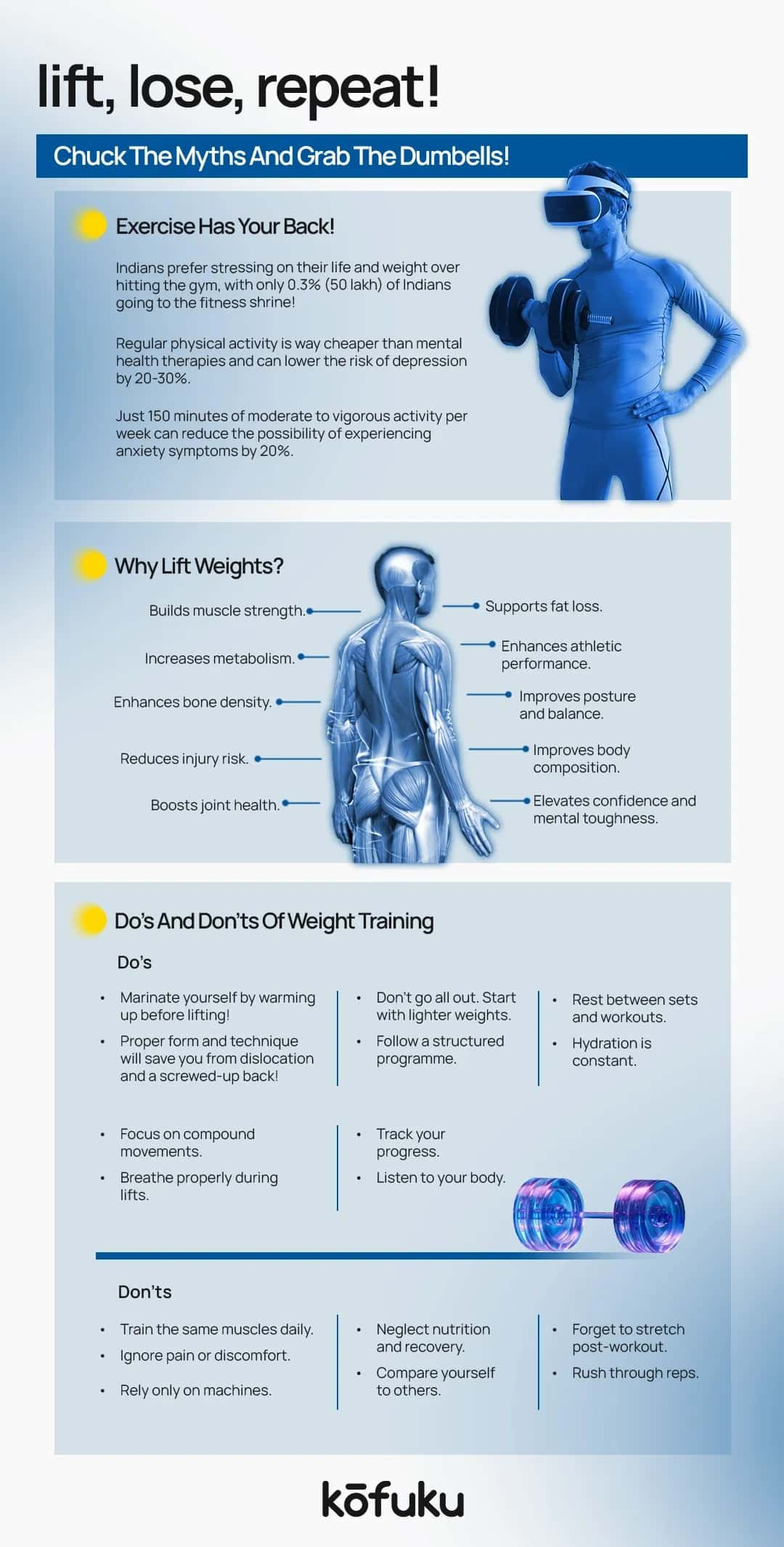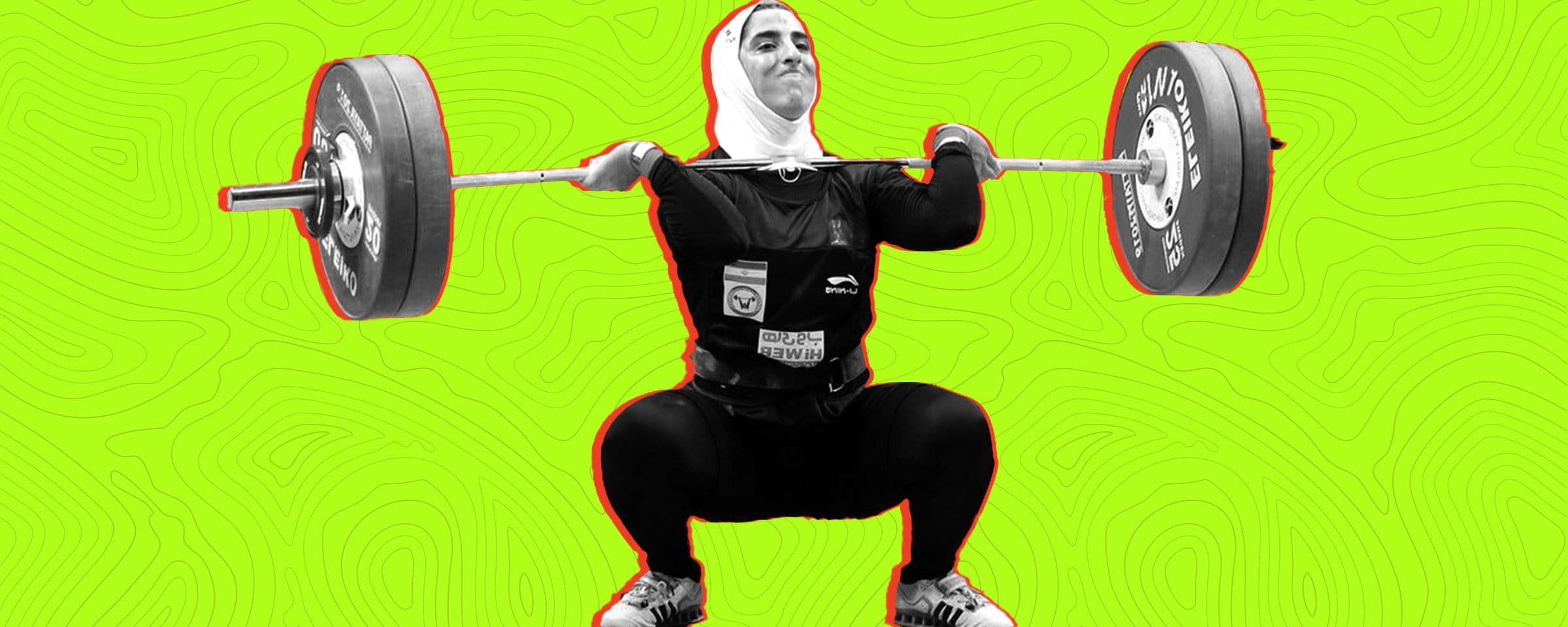10 Weirdest Myths About Weight Training

Introduction
Working out is pretty straightforward. You dress up in your athletic best, go to the gym, and start doing random things with dumbbells. Every once in a while, you’re exercising in your zone, and then a seasoned lifter will come and whisper in your ear, “Tsk tsk - what is this light weight nonsense? You have to lift heavy. Go big or go home bro!”.
Introducing weight training myths. A bunch of lies so carefully curated, you’d think it’s true. Some rightfully absurd statements - that will have you scrambling for the truth, because let’s face it - the truth will set you free. Or, at the very least, ensure you squat correctly.
Without further ado, here are the 10 weirdest myths about weight training that you need to know.
It’s a guy thing
If your impression of the gym was a sweaty dude going through the motions, you couldn’t be further from the truth. The idea that the gym is just for men is as absurd as the reasons that men have given for this myth. The idea that only dudes frequent the weight room is outdated.
From female warriors in ancient cultures to modern athletes like Serena Williams or Simone Biles, women have been training hard long before the fitness industry tried to sell it as “just for men.”
Today, if you walk into a yoga class, pilates studio or a CrossFit box, you’ll see a lot of strong, dedicated women showing up and crushing it. Women are lifting, running marathons, doing MMA, hiking, etc. Even powerlifting. And you know what? They’re killing it.
Results are immediate
Strength training is the most effective way to pack on some lean, shapely muscle. Like most good things, it won’t happen overnight. You need to invest in it and stay consistent. Do that, and you’ll see real and accurate results after six to eight weeks.
Slacken, and your body will deteriorate accordingly. Real progress takes time, consistency and patience. While you might feel a tad bit better or lose water weight early on, visible changes such as fat loss or muscle gain often take weeks or months.
First, your body will adapt, and then, it’ll give you results based on nutrition, genetics and sleep. Fitness is a long-term journey. Trust the process. Stick with it.
Lifting too much will make you manly
Ladies, this one’s for you. A lot of women are physiologically unable to build muscle to the degree where they would be considered “bulky”. It’s not possible because it’s an estrogen function and a lack of testosterone.
Ladies, fear not - you’ll never build muscle like a man unless you are trying to achieve that result. You will get feminine curves - bonus points if you keep the rests between sets really short.
The less you stop between exercises, the more calories you will burn, resulting in a lean, sculpted appearance.
You absolutely have to take supplements
This is another lie perpetuated by the supplement industry to ensure sales. No, you don’t need to take supplements, especially when starting in the gym. Follow your diet properly, and eat clean.
You will see results. There’s no need to flirt with whey protein just because the buff dude on the box tickles your fancy. Don’t get me wrong. Supplements are great. And if you can properly follow instructions while taking them, they actually might do you some good.
But if you are a novice or a beginner, taking caffeine-rich pre-workout supplements will only make you anxious.
Taking an ice bath after a tough workout improves recovery
Plunging into an ice bath after a particularly difficult workout session is tempting and an insurance against injury because it brings down inflammation. However, not all inflammation is bad inflammation. Jumping into an ice tub after every workout can stop the repair process.
When you weight-train, you create useful inflammation by strategically stressing your muscles. As your body heats, strength builds. Suppose you want to tend to a particular injury. Ice the injury itself. The same goes for OTC pain medications.
Only use them if you’re treating an injury. Saunas might be safer and more effective for overall recovery after a workout.

Weight training is exclusively for the young
The myth that weight training is solely meant for the young is completely false. Strength training is beneficial at any age, but it is especially beneficial for older adults. It helps preserve muscle mass, improve balance, boost bone density, and prevent age-related decline.
In fact, regular weight training can reduce the risk of falls and injuries while boosting independence and quality of life. If proper guidance and form are correct, people in their 60s, 70s and beyond can lift weights safely and effectively.
Weight training helps manage chronic conditions such as arthritis and type 2 diabetes. Regular strength training also improves mood and cognitive function. Age must never be a barrier to building strength. Fitness is for life—it isn’t a thing for youth.
Machines are better than free weights
Many people believe that machines are safer than free weights. That’s not always true. Machines are great because they offer guided movements and reduce the risk of improper form for beginners.
They curtail your range of motion and don’t effectively engage stabilising muscles. Free weights mimic real-life movements and build functional strength. When done with proper form, free weight exercises are just as safe and more beneficial than machines.
Relying on machines can result in muscle imbalances and slower progress. Depending on goals and experience levels, a balanced routine must include both.
You have to weight-train daily to see results
Consistency is key. And consistency doesn’t mean every day. The belief that you must work out every day is a common fitness myth. In reality, rest and recovery are just as vital as exercise.
Working out daily without giving your body time to heal can lead to overtraining, injury and fatigue. Muscles grow and repair when you’re resting, not while you’re working out. What’s better?
Follow a balanced routine with active recovery days of varying intensity and rest days incorporated. Quality is better than quantity. Listen to your body, stay consistent, and give recovery time for long-term results and sustainability.
Unless you’re sore, progress ain’t happening
The idea that you must be sore to see progress is a myth. Muscle soreness, also known as DOMS (delayed-onset muscle soreness), can happen after a new or intense workout. Soreness means your muscles are adapting to something different—not necessarily building strength or losing fat.
As you get more serious with training, soreness goes away, even though improvements are still happening. Progress is measured better through increased strength, endurance, better form, or changes in body composition, not soreness.

Weight training burns fewer calories than cardio
For a long time, people have been buying into the myth that if they want to burn calories, they need to do endless amounts of cardio. But what is true is that actually boosting your resting metabolism (the number of calories you burn all day, not just when your body is in motion) requires picking up weights to boost your lean mass.
When you are strength training, your muscles burn 50% more calories than the muscles of a runner or a cyclist. Weight training builds muscle, which increases your resting metabolic rate—meaning you burn more calories even while resting.
Weight training also creates an “afterburn effect” (EPOC), where your body burns more calories post-workout. Over time, this ensures that weight training is highly effective for fat loss.
Conclusion
Weight training is often misunderstood, surrounded by persistent myths that result in unnecessary fear or confusion. From the idea that it’s exclusively for bodybuilders to misconceptions regarding safety, soreness, and calorie burn, these false beliefs can prevent people from experiencing its full range of benefits.
In truth, weight training remains a powerful, versatile tool for boosting strength, metabolism, mental health and overall fitness - for people of all ages and backgrounds.
Shattering such myths helps establish a more informed, confident and empowered approach to fitness. Lifting weights isn’t complicated - get to it, and ensure a stronger you
FAQs
How do I know if I’m lifting the right weight?
Start with a weight that allows you to complete your sets with good form but still feels challenging by the last few reps. Gradually increase the weight if you’re easily finishing your sets without difficulty.
Can weight training help with mental health?
Yes! Weight training can boost endorphins and reduce stress, anxiety, and depression. It also improves self-esteem and body image, contributing to better mental well-being.
Should I train different muscle groups on separate days?
Split muscle groups into different workout days to allow for adequate recovery. A common split could be training the upper body one day and the lower body the next.
What’s the best way to prevent injury while lifting weights?
Focus on proper form, start with lighter weights, warm up before workouts, and incorporate rest days. Using controlled movements, especially when lifting heavier weights, can significantly reduce the risk of injury.
Is cardio necessary for a weight-training routine?
While cardio isn’t essential for weight training, it can complement your routine by improving cardiovascular health and burning additional calories.


Debunking the Weightlifting Myth – Truth Revealed

10 Recovery Techniques for Fitness Enthusiasts

Discover the Benefits of Natural Fitness

Hottest Fitness Trends in 2025

Sustainable Weight Loss Tips to Achieve Long-Term Fitness Goals


